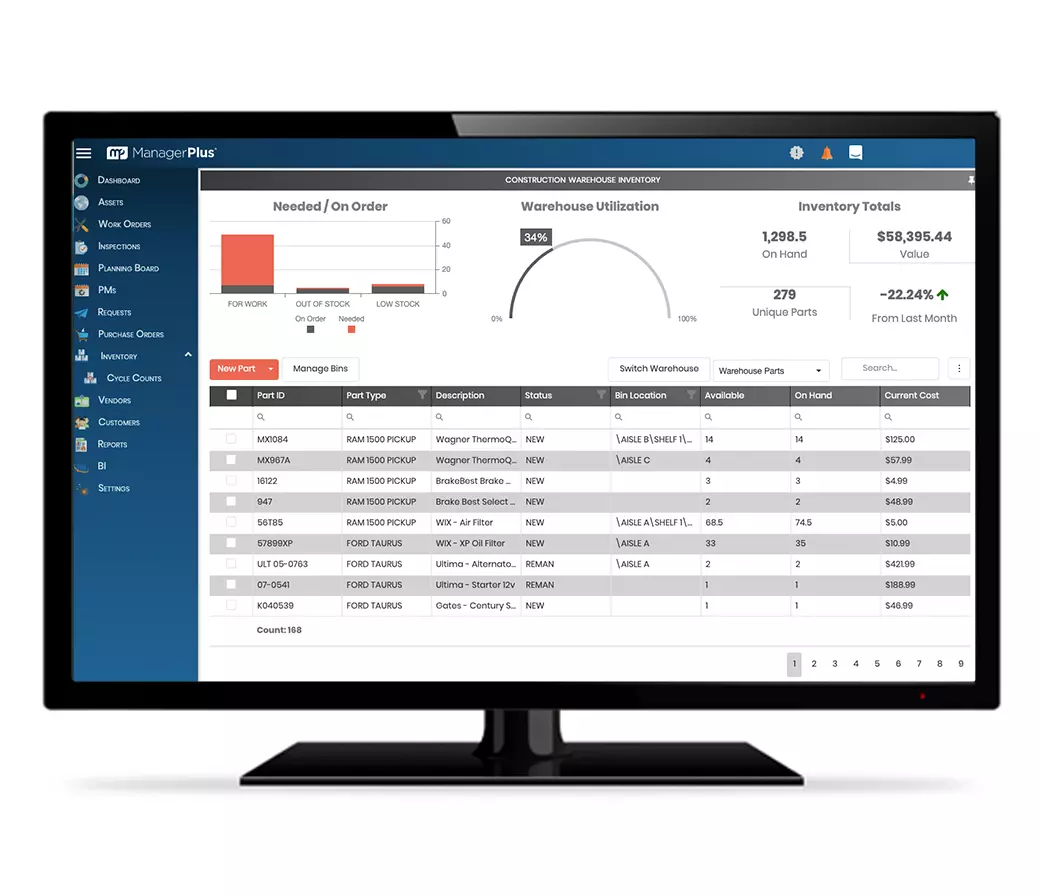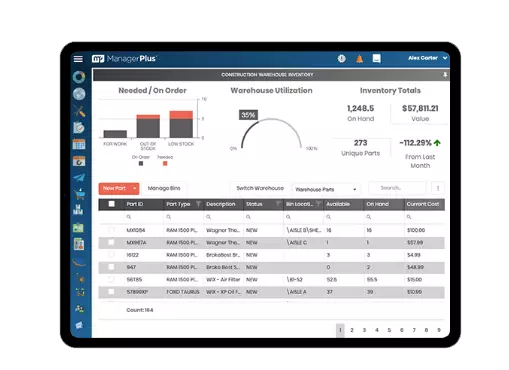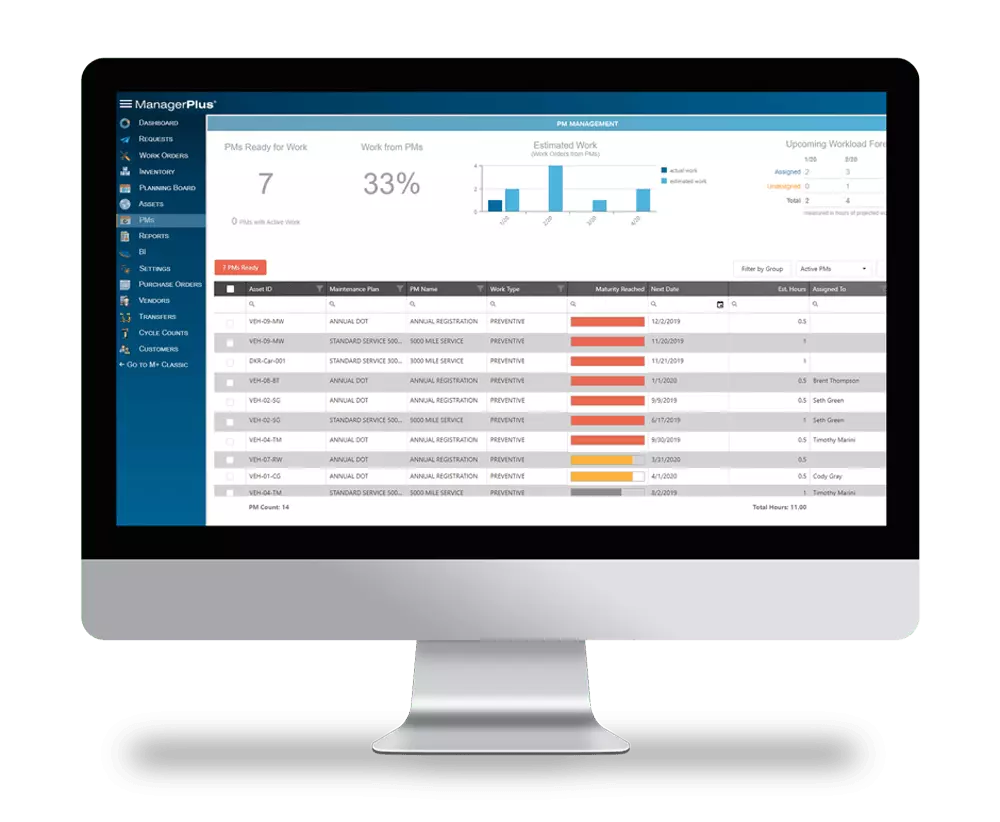Most companies don’t fully understand the benefits of good inventory management software or how effectively managing inventory can save them money.
With as much as 90% of maintenance, repair, and operations (MRO) inventory going unused every year, managing your inventory properly can have a bigger impact on your bottom line than you might think.
Let’s look at some of the biggest benefits of good inventory management, including some that might not immediately come to mind.
What is inventory management?
Inventory management is the philosophy and procedures your organization has in place to manage your maintenance, repair, and operations (MRO) inventory, the parts you need to keep your assets and equipment functioning properly. More specifically, it is the point in your supply chain where your parts are tracked in an out of your warehouse.
Inventory management includes everything from purchasing inventory, to storing and tracking it across your locations, to assigning and tracking it across your work orders and maintenance operations.
Advantages of inventory management systems
Managing inventory properly is much more than just making sure you have parts in your warehouse. The ultimate goal of inventory is to have the right part in the right place at the right time, and inventory management helps you accomplish all three.
Inventory management helps you avoid unnecessary costs connected to holding more inventory than you need, avoiding expensive rush shipments, and even reducing equipment downtime.
Some of the biggest benefits of good inventory management are:
- Reduced costs
- Increased equipment uptime
- Greater visibility
Save money by only buying what you need
Many purchasing and inventory managers will either buy parts in bulk when they get a good deal from the supplier, or they don’t really know what they need and wait until equipment fails before ordering the necessary parts.
The truth is, quite a few companies hold on to much more inventory than they actually need because they aren’t tracking their inventory across their maintenance work. Companies who aren’t effectively managing inventory will either operate off of gut instinct or wait until they run out to order more.
Inefficient inventory management means technicians pull parts as needed, but the amount of stock remaining isn’t updated until the next audit or until a technician goes to pull a part only to discover that you’ve run out.

How many times have you run out of parts at the worst possible moment? Have you ever had critical assets fail and you end up losing valuable time because you’ve got operators standing around on the clock with equipment that isn’t working, waiting on parts to come in?
Not only are you losing money on wasted labor, but you now also have to pay extra for a rush shipment of parts that you could have ordered a few days ago if you’d only known you needed them.
When you’re using an effective inventory management system, you know exactly how often techs use parts, which parts you’re using more frequently than others, and when it’s time to order more so you never waste time and money waiting.
Keep equipment running with the right parts
As a maintenance manager, a big part of your job keeping equipment running at peak performance for as long as possible. A large part of your team’s ability to perform maintenance work is tied to having the right parts on hand when they need them.
In fact, according to the Aberdeen research group, half of all unplanned equipment downtime can be traced back to a lack of parts. That means that by just simply managing your inventory more efficiently, you can increase your equipment uptime by 50%.
A strong preventive maintenance strategy is one of the best ways to optimize your assets and keep them running better, longer and by definition, preventive maintenance is about anticipating when equipment will need maintenance and fixing it before it breaks.
A large part of any preventive maintenance program is planning ahead for important maintenance work, but if you don’t have any way to track and manage inventory, you can’t plan ahead. With good inventory management software, you can see your maintenance schedule well in advance, and because you’ve been tracking your inventory across your work orders, you know when it’s time to order the parts your technicians will need.
Gain greater visibility into your operations
It’s had to make good business decisions without good data and with all the technology available today, it’s incredibly easy to gather solid data on your inventory. With an effective inventory management system in place, you can quickly discover things like:
- Excess inventory
- Inefficient maintenance schedules
- Hidden costs
When you’re properly managing your inventory, you can gain valuable insights into exactly where your parts are and how they’re being used across your organization. With the right cloud-based inventory management software, all your inventory data is update in real-time so always have an accurate picture of current use and levels.
 You can keep track of every step of your inventory and access the information wherever you are. Your technicians can see inventory levels from their connected devices and parts claimed by work orders are instantly marked as unavailable in the database. The moment a part is claimed by a work order, the inventory levels are automatically updated so a technician assigned to a different work order can’t take it.
You can keep track of every step of your inventory and access the information wherever you are. Your technicians can see inventory levels from their connected devices and parts claimed by work orders are instantly marked as unavailable in the database. The moment a part is claimed by a work order, the inventory levels are automatically updated so a technician assigned to a different work order can’t take it.
The most important thing about greater visibility is that it helps you make informed purchasing decisions. Once you know exactly where and how your inventory is being used, you can better decide how to spend your money on not only your inventory, but your warehouse, labor, even your supplier relationships.
Hidden benefits
We’ve seen how efficiently managing your inventory can have a positive impact on your business and you probably already have some idea about how you can improve the areas we’ve mentioned. But there are even more benefits to a well managed inventory that you might not always think about.
Some of the biggest “hidden” benefits of inventory management systems are:
- Reducing overstock
- Cutting costs on insurance
- Better supplier relationships
- Recovered labor hours
- Discovering inventory and assets
You know you have overstock, but do you know how much?
Most organizations carry more inventory than they need, and that is a generally accepted best practice for a few particular pieces of inventory.
What you may not know is that as much as 90% of MRO inventory goes unused every year. That means that most maintenance teams are only using about 10% of their inventory in a given year. That’s a lot of inventory that either gets thrown out due to obsolescence or expiration, or that just sits, collecting dust, taking up space in your warehouse.
Using a cloud-based inventory management software lets you track your inventory across your operations so you can get an in-depth look at exactly what parts you’re using. You can quickly narrow down the 90% of your inventory that you don’t need to hold on to so you can quickly start saving money.
 Another way to help figure out what you need and what you don’t is to determine your asset criticality. Evaluate your assets in terms of how vital they are to your production, or in other words, how much trouble your production lines would be in if the asset were to fail.
Another way to help figure out what you need and what you don’t is to determine your asset criticality. Evaluate your assets in terms of how vital they are to your production, or in other words, how much trouble your production lines would be in if the asset were to fail.
Cut warehouse costs you may not have considered
Some of the often overlooked costs of carrying inventory have to do with warehouse space. When you’re carrying inventory, you’re having to pay for the extra warehouse space. This includes things like utilities, insurance, and maybe even rent. When you are managing your inventory efficiently, you can significantly cut down the amount of warehouse space you need which can end up saving you quite a bit in these extra costs that you may not have thought about.
Even things like the opportunity costs of not being able to use that space for something more useful are things to consider. If you can eliminate a large portion of space currently being used for inventory, then you can repurpose that space for more production equipment or anything else more useful to your business than just shelves.
Optimize your supplier relationships
As we mentioned before, it’s not uncommon for some inventory and purchasing managers to operate on gut instinct, buying parts based on what they think they might need or to purchase parts they don’t really need because they are offered a good deal from the supplier.
When you’re properly managing your inventory, you have actual, hard data about what parts you use so you don’t have to rely on your gut and can justify passing on the “good deal” because you have the numbers to prove you’ll still save money in the long run.
One thing you can do as well is begin to push some of the holding costs of your inventory back onto your suppliers. When you’re only ordering as needed, your supplier is the one who is managing and holding the inventory instead of you.
This tends to work really well for those high-use, low-cost items that you know you’ll need a lot of, but you don’t need to spend money storing. For example, if you can see from your inventory management software that you’re using 100 units of a certain item every 2 weeks, you can have the supplier deliver the next 100 every 12 or 13 days so you’re only ever holding onto a few parts instead of the entire shipment.

When your supplier is holding inventory for you, it also gives you a chance to evaluate how efficient your suppliers are. In the previous example, if your supplier is late every other shipment, then you can quickly reevaluate and find a more reliable supplier.
This is trust is useful for highly critical inventory items as well. Once you’re established your trustworthy suppliers, you can arrange to have them hold onto some more critical items as well because you can trust that when you need the parts, they’ll deliver them on time.
Get back wasted labor hours
With a large, poorly managed inventory, it’s sometimes easy to overlook all the extra labor it’s costing you to keep those parts around. The biggest way inventory management software can save you on labor costs is by automating manual tasks you’ve been paying someone to do. For example, barcoding. If you have someone manually checking in and entering each part into a spreadsheet as it comes into the warehouse, you’re wasting a lot of time and money.
The same is true if you have a manual system for pulling and updating inventory. If your technicians have to email or physically check in with someone every time they need to pull parts and materials from the warehouse, that’s a lot of wasted time. With inventory management software, you can automatically assign parts to regularly scheduled maintenance and if a tech needs an extra part, they can simply scan it out and the database is updated instantly.
If you end up being able to cut down your warehouse space, that’s also less floor and shelf space that you’re having to pay someone to clean.
Basically, one of the best “hidden” benefits of good inventory management is that it frees up a lot of wasted labor hours to let your team focus on doing other, more productive tasks. Your team becomes more efficient and everyone wins.
Find parts and assets you didn’t know you had
One of the biggest unknown benefits of implementing inventory management software is actually part of the process itself. Many times, as part of the implementation process, the software provider will come out and perform a complete audit of your assets and inventory to help you get started using the program.
This audit not only helps you save time and money by letting someone else do the heavy lifting of auditing and importing all your inventory and assets, but it can also help you discover assets and inventory that you may not even know you have.
Having a much clearer picture of your assets and inventory can go a long way in helping you optimize your maintenance, asset, and inventory management operations.

Differences between ERP and EAM inventory management systems
When it comes to managing operations at your organization, there are two main overarching approaches to it: enterprise resource planning (ERP) and enterprise asset management (EAM).
There is a lot of debate around the pros and cons of these two approaches to managing your business operations, but the truth is that they are designed to do different things. Even though they have many overlapping features, they aren’t interchangeable and what approach works for one organization may not work for another.
ERP systems are designed to be very wide ranging and cover as many different aspects of your business operations as possible. The goal is to eliminate duplicate or competing software systems by combining all your activities into one centralized location. It’s meant to be a jack-of-all-trades system for your entire organization.
ERP solutions can handle HR systems, accounting systems, customer relationships and more.
EAM software is also wide ranging and has many useful features and uses for your business, but it is more specifically targeted at helping you better manage your physical assets. Instead of encompassing every possible aspect of your operations, it helps you focus more specifically on monitoring and maintaining your assets.
With EAM software, you can fully optimize and streamline your asset maintenance operations and track every part of your asset journey, including inventory, work orders, and more.
Although ERP software allow you to generate reports on you company operations, it does not include maintenance and asset tracking components, so it’s hard to get a complete picture of you operations.
Since EAM software does track your maintenance and asset operations, you can generate business intelligence reports that show you exactly what’s going on with your assets and where your money is going.
For many years, companies liked the idea of the “one-stop-shop” solutions offered by ERP software, and began to try to incorporate them across their organizations. As technology advanced and cloud-based solutions become more robust and more widely available, businesses jumped at the chance to incorporate all their systems into one platform.
The problem is that for complex organizations with several large physical assets that directly affect the bottom line, ERP software doesn’t quite offer the full picture. Many such companies are now turning to a hybrid solution of using a robust EAM software for tracking their assets that integrates well with their ERP software, or at least generates reports that are easy to import into the ERP platform.
Benefits of using EAM inventory management software
We’ve already seen how developing a good inventory management system can be good for your business and implementing a good EAM solution is the best way to do that.
EAM software helps you:
- Track inventory
- Automatically update stock levels
- Manage costs
Track every part everywhere
One of the goals of inventory management is making sure you have the right part in the right place at the right time. When you’re tracking your inventory with EAM software, every piece of inventory is scanned as it comes into you warehouse, and because the software lives in the cloud, your database is updated in real time as the part moves through your organization.
That means that as soon as it’s in the correct bin, it’s available to be pulled for a work order. You can also set certain routinely used parts to be automatically assigned to routine work orders so the moment that work order is generated, the part is claimed as well so it can’t be pulled for another job.
This is extremely useful for companies with multiple warehouses or inventory locations. If you’re not using EAM software, you may go check the bin closest to you and because it’s empty, you might think you need to order more when the truth is that you have more at another warehouse. Instead, you can simply check the database, instantly see exactly where the part is, and arrange for someone to bring it.

Always know exactly how much you have
Spreadsheets may seem like a useful way to manage inventory levels, but they still require manual input and the moment you email it out to someone, it becomes a copy of the database an is no longer the source of truth. Plus, everyone must remember to manually update the database whenever they pull a part for a job.
With EAM software, you can always see exactly how much inventory you have. Your database lives in the cloud, not in a spreadsheet so when a technician goes to pull a part and scans it on their mobile device, your stock levels are instantly updated.
You can also set you min and max levels and be notified when they are reached so that you can always know when it’s time to order more. For instance, if you know it takes three days for your shipment to arrive, you can set your min levels to notify you when you have three days of parts remaining so that you can order them in time.
As we mentioned earlier, this is great to help you plan for maintenance work as well. If you know you’re going to have a big PM coming up, you can make sure you order any additional parts ahead of time so that your team has everything they need to get the job done without missing a beat.
Keep track of every budget dollar
You can’t know how to save money if you don’t know how you’re spending it in the first place. With EAM software, you can generate detailed reports on exactly how your spending money on your inventory. You’ll be able to see which parts you’ve been carrying too much of and discover some parts you may be able to have your suppliers hold on to until you need them.
You’ll quickly be able to discover places where you can be saving money and how you can optimize your inventory budget so you can improve your ROI. The best part is you’ll have verifiable data you can show to your executive team to prove how much value you’re adding to the company’s bottom line. You can customize the cost reports based on the KPIs that matter most to your organization and show exactly how much you and your team are benefitting the company.
Next steps
Improving your inventory management is as easy as reaching out to talk with the experts about the inventory challenges you’re currently facing. Our team of experts has extensive knowledge on how to improve your inventory management operations and are more than happy to chat with you to find out how our ManagerPlus EAM software can help.
Set up a conversation with us or even schedule a live demo when it’s convenient for you and our team will reach out and answer any questions you might have. Even if you’re unsure if it’s the right solution for you, the best thing you can do is ask.
Executive summary
All too often organizations don’t place enough emphasis on proper inventory management, but the truth is that managing your inventory can save you quite a bit of money.
There are even additional hidden benefits of good inventory management such as:
- Reducing overstock
- Cutting costs on insurance
- Better supplier relationships
- Recovered labor hours
- Discovering inventory and assets
The best way to discover these benefits is to implement a robust inventory management software as part of a full-service EAM solution. ManagerPlus from iOFFICE can help you discover all these benefits and more.


